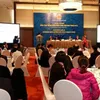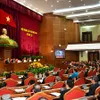Cancer burden in Vietnam – Conclusion: Avoidable consequences
Contrary to popular belief that a diagnosis of cancer means a death penalty, experts have asserted otherwise.
The cancer burden would be significantly eased by adopting a comprehensive preventative model, made possible with competent agencies’ effective administrative role and improved awareness.
Dr. Nguyen Chan Hung, chair of the Cancer Association of Vietnam, warned that diets rich in animal fat and meat, tainted food, dried salty fish or pickled vegetables, or insufficient vegetables and fruits are among the contributory factors of different types of cancer.
Those who smoke or drink heavily, and lead a sedentary lifestyle, also stand higher risks of contracting the illness.
According to Dr. Tran Thi Anh Tuong, vice head of the Nutrition Department of Ho Chi Minh City Oncology Hospital, all cancers start because abnormal cells grow out of control.
Cancerous cell growth is different from normal cell growth.
Instead of dying, cancerous cells continue to grow and form new, abnormal cells.
Cancer cells can also invade, or grow into, other tissues, something that normal cells cannot do.
Except for some unavoidable factors including genetic elements and old age, other causes are preventable thanks to a healthy lifestyle and adequate knowledge of the disease.
Early diagnosis saves lives, cuts costs
Dr. Mai Trong Khoa, deputy director of Bach Mai Hospital in Hanoi and director of the Nuclear Medicine and Oncology Center, told Tuoi Tre(Youth) newspaper earlier this month that approximately 100,000 out of 125,000 new cancer patients in Vietnam die of the illness each year.
New cancer cases have gone up especially fast recently, while the mortality rate has also been on the rise.
As many as 76% of cancer patients in Vietnam have been diagnosed and hospitalized at the terminal stage, which has considerably undermined the effectiveness of treatment, increased costs, and cut short patients’ life expectancy following the treatment.
Dr. Tran Van Thuan, head of the Research Institute for Cancer Prevention and Control, stressed that prevention against cancer is remarkably safer and cheaper than its treatment.
For instance, it only requires one surgery and endocrine supporting treatment if breast cancer is detected in its initial stage.
With treatment costing around VND10 million (US$ 441) for each session, 95% of patients are cured of the disease.
However, if the illness is detected in the second or third phases, apart from surgeries and endocrine treatment, the treatment process will also include chemotherapy and radiotherapy, which all augment costs to VND60-70 million ($2,649- 3,090) while cutting patients’ survival rate after five years down to 50 or 60%.

If the disease is not diagnosed until the fourth stage, costs of lengthy treatment can amount to VND100-150 million (US$4,414- 6,622) and survival rates after five years drop to a mere 10%, Dr. Thuan added.
Meanwhile, Dr. Le Thi Thu Suong, vice head of the Oncology Department of Cho Ray Hospital in Ho Chi Minh City, recommended regular health check-ups and screening tests.
Proper treatment should also be sought for inflammation-caused damage, and an endoscopy in the stomach and colon should be adopted when worrying symptoms arise.
Meanwhile, Tran Dac Phu, head of the General Department of Preventive Medicine, said that Vietnam has recently implemented preventive programs on non-contagious diseases, including cancer.
Coupled with treatment for patients, preventive programs are expected to radically reduce new cancer cases.
Insurance inadequate
Dr. Thuan, head of the Research Institute for Cancer Prevention and Control, urged that medical insurance cover cancer screening test fees.
Around 74% of Vietnamese people are on medical insurance policies, a number which has been rising recently.
However, cancer screening tests have only been conducted on a small scale across the country, Dr. Thuan noted.
According to Bach Quoc Khanh, deputy head of the National Institute of Hematology and Blood Transfusion, medical insurance pays an estimated VND200 billion (US$8.82 million) each year for medication used by chronic leucopenia patients.
Nguyen Ta Tinh, head of the Vietnam Social Insurance’s pharmaceutical department, said the agency spent a total of over VND30 trillion (US$1.32 billion) on medication in 2015, a large portion of which was set aside for cancer medicines, particularly expensive drugs.
However, over the past six years, many other kinds of costly medication remain out of cancer patients’ reach, partly contributing to their premature deaths.
Dr. Khoa, deputy director of Bach Mai and director of the Nuclear Medicine and Oncology Center, said the country’s medical insurance fund could hardly afford screening test fees.
He stressed that in order to combat cancer effectively in Vietnam, it is vital to disseminate knowledge of cancer prevention and treatment to the general public, encourage them to lead a healthy lifestyle, and take regular health check-ups.
Other actions such as social mobilization, vaccination, and palliative care should also be considered to prevent the disease, he added.
Tags:





